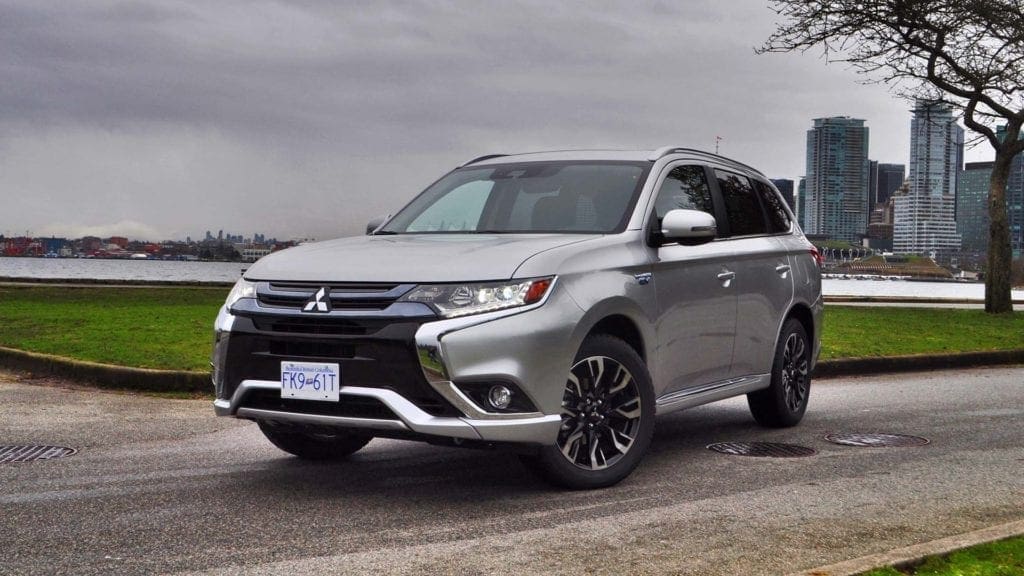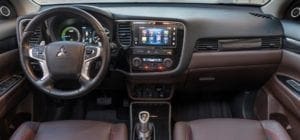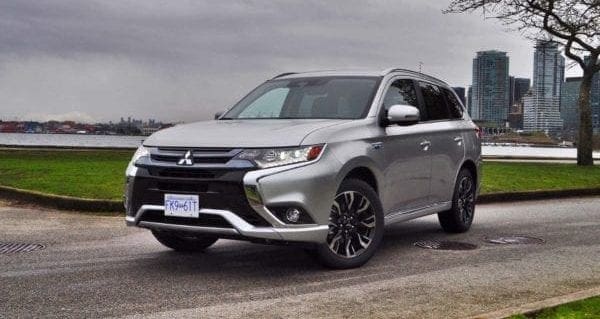
The Mitsubishi Outlander PHEV has three separate drivetrains and the vehicle will automatically select the best one, depending on driving conditions. In the EV Drive Mode, it’s driven by the two electric motors, with energy being supplied exclusively by the battery pack.

Most car companies are run by accountants – bean-counters. That’s probably the way it has to be: bottom line, profit and loss, mollifying the stock-holders and so on.
But there are a few where the engineers still have sway and where management actually listens to them. Saab was one (and look where it got them, but never mind), Subaru is another, as is Mitsubishi. These three have put forward some truly interesting automobiles over the years.
And Mitsubishi continues to do so.
Take the Outlander PHEV. This is taking hybrid technology, kicking it up a notch, and manufacturing a car that’s too smart by half, as my granny would say. Perhaps too smart for its own good.
Internal combustion power for the plug-in Outlander PHEV is provided by a 2.0-litre, four-cylinder, with two electric motors augmenting the drivetrain. One is mounted in the front of the vehicle, while the other is back near the rear axle. The front electric motor, incidentally, is a tweaked version of the same unit used in Mitsubishi’s i-MiEV fully electric vehicle. It has a continuous variable transmission (CVT).
The battery pack is a high-capacity 12kWh lithium-ion arrangement. The pack consists of 80 cells configured in a series, with a total voltage measuring 300V and a total storage capacity of 12kWh.

Outlander PHEV has all the technical attributes, but these seem to come at the expense of simple user-friendly modern conveniences
What‘s really interesting about the Outlander PHEV is that there are three separate drivetrains and the vehicle will automatically select the best one, depending on driving conditions. In the EV Drive Mode, it’s driven by the two electric motors, with energy being supplied exclusively by the battery pack. This mode is best suited for running errands and city schlepping. The Outlander PHEV can run in 100 percent EV mode in four-wheel-drive, something no other plug-in hybrid SUV on the Canadian market can do.
When the battery pack starts to fade, or when you need sudden and/or additional degree of acceleration, the two electric motors provide additional electricity via the gasoline-powered generator – hence, Hybrid mode. In this configuration, the gasoline-powered generator also helps charge the lithium-ion drive battery pack, while providing additional power to the pair of electric motors.
If that’s not enough, there’s a Parallel Hybrid mode where the gasoline engine drives the front wheels while automatically switching the system for engine-powered travel at high speeds or steady highway cruising.
Not done yet. Underway, you can choose from a Battery Save mode, where the system automatically conserves the current state of charge within the battery pack, or Eco mode, which reduces both fuel and electricity usage for increased efficiency with the touch of the button. EV Priority mode, which prioritizes the electric propulsion system, and – my favourite – Battery Charge mode, which allows you to charge the vehicle while it’s being driven.
Charging time is about eight hours with regular household current and three hour with a “fast charge” set-up.
What’s it like to drive?
Surprisingly lively. Give it some welly and you’re clipping along before you know it. Judicious use of the various modes will help extend battery power, but without any kind of assist, your range is around 60 kilometres, give or take.
A couple of gripes. First, the headlights are extremely ineffective. While bright enough, they only throw the beam for a few feet in front of the vehicle. Dark country roads are definitely an adventure without the use of high-beam, which is only marginally better. Mitsubishi needs to have another look at this.
Ditto with the heater. In a word, it sucks. Regardless of the mode you’re in, you have to really crank it up to get any kind of sustained warmth from the system. I found myself continually fiddling with it to get the right balance of heat and ventilation and it never was quite what I needed. Again, the manufacturer needs to revisit this.
Also, the transmission is far too leisurely during takeoff. Just keeping up with traffic means almost burying the gas pedal to get up to speed, which kind of defeats the purpose.
Last but not least, the whole vehicle is just too fiddly for my tastes. I definitely appreciate its technical attributes, but these seem to come at the expense of simple user-friendly modern conveniences.
2018 Mitsubishi Outlander PHEV
Engine: 2.0 litre four cylinder twin electric motors
Transmission: continuous variable transmission (CVT)
Drive: all-wheel drive
Horsepower: 117 horsepower at 4,500 rpm; 160 hp from electric motors
Torque: 137 foot pounds at 4,500 rpm; 240 foot pounds from electric motors
Base price: $42,998.
Fuel economy: 3.0 litres/100 km (city) and 3.4 (highway) on regular gas
Some alternatives: Acura MDX Sport Hybrid, BMW XDrive 40e, Lexus RX450h, Toyota Highlander Hybrid, Volvo SC90 T8, Mercedes 350e 4Matic.
Ted Laturnus writes for Troy Media’s Driver Seat Associate website. An automotive journalist since 1976, he has been named Canadian Automotive Journalist of the Year twice and is past-president of the Automotive Journalists Association of Canada (AJAC).
The views, opinions and positions expressed by columnists and contributors are the author’s alone. They do not inherently or expressly reflect the views, opinions and/or positions of our publication.


